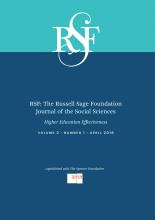Research ArticleIV. Teaching and Learning: Contexts and Practices
Open Access
Aligning Science Achievement and STEM Expectations for College Success: A Comparative Study of Curricular Standardization
Siqi Han, Claudia Buchmann
RSF: The Russell Sage Foundation Journal of the Social Sciences April 2016, 2 (1) 192-211; DOI: https://doi.org/10.7758/RSF.2016.2.1.09
Siqi Han
aPh.D. candidate of sociology at the Ohio State University
Claudia Buchmann
bProfessor and chair of sociology at the Ohio State University

REFERENCES
- ↵
- Allmendinger, Jutta
- ↵
- ↵
- ↵
- ↵
- Baker, David P.,
- Brian Goesling, and
- Gerald K. LeTendre
- ↵
- Bishop, John H
- ↵Bishop, John H. 2006. “Drinking from the Fountain of Knowledge: Student Incentive to Study and Learn—Externalities, Information Problems and Peer Pressure.” In Handbook of the Economics of Education, vol. 2, edited by Eric Hanushek and Finis Welch. Amsterdam: Elsevier. Accessed February 23, 2016. http://www.sciencedirect.com/science/article/pii/S1574069206020150.
- ↵
- ↵
- ↵Chen, Xianglei, and Matthew Soldner. 2013. STEM Attrition: College Students’ Paths into and out of STEM Fields. Statistical Analysis Report. NCES 2014–001. Washington: U.S. Department of Education. Accessed February 23, 2016. http://files.eric.ed.gov/fulltext/ED544470.pdf.
- ↵
- Chiu, Ming Ming, and
- Lawrence Khoo
- ↵Darling-Hammond, Linda. 2010. The Flat World and Education: How America's Commitment to Equity Will Determine Our Future. New York: Teachers College Press.
- ↵
- Goldhaber, Dan D., and
- Dominic J. Brewer
- ↵Grossman, Tabitha, Ryan Reyna, and Stephanie Shipton. 2011. Realizing the Potential: How Governors Can Lead Effective Implementation of the Common Core State Standards. Washington, D.C.: National Governors Assocation, Center for Best Practices. Accessed February 23, 2016. http://eric.ed.gov/?id=ED532524.
- ↵
- ↵
- Levels, Mark, and
- Jaap Dronkers
- ↵Levels, Mark, Jaap Dronkers, and Christopher Jencks. 2014. “Mind the Gap: Compositional, Cultural and Institutional Explanations for Numeracy Skills Disparities Between Adult Immigrants and Natives in Western Countries.” HKS Faculty Research working paper RWP14-020. Cambridge, Mass.: Harvard University. Accessed February 23, 2016. https://research.hks.harvard.edu/publications/getFile.aspx?Id=1048.
- ↵
- Maple, Sue A., and
- Frances K. Stage
- ↵
- Marsh, Herbert W.,
- Adel Salah Abduljabbar,
- Philip D. Parker,
- Alexandre J. S. Morin,
- Faisal Abdelfattah,
- Benjamin Nagengast,
- Jens Möller, and
- Maher M. Abu-Hilal
- ↵
- Marsh, Herbert W., and
- Kit-Tai Hau
- ↵
- ↵
- ↵
- Nagengast, Benjamin, and
- Herbert W. Marsh
- ↵National Academy of Sciences. 2007. Rising Above the Gathering Storm: Energizing and Employing America for a Brighter Economic Future. Washington, D.C.: National Academies Press. Accessed February 23, 2016. http://www.nap.edu/catalog/11463/rising-above-the-gathering-storm-energizing-and-employing-america-for.
- ↵National Research Council. 2012. A Framework for K-12 Science Education: Practices, Crosscutting Concepts, and Core Ideas. Washington, D.C.: National Academies Press. Accessed February 23, 2016. http://www.nap.edu/catalog/13165/a-framework-for-k-12-science-education-practices-crosscutting-concepts.
- ↵OECD. 2007. PISA 2006: Science Competencies for Tomorrow, vol. 1. Paris: Organization for Economic Cooperation and Development. Accessed February 23, 2016. http://www.oecd-ilibrary.org/content/book/9789264040014-en.
- ↵OECD. 2009. PISA Data Analysis Manual: SPSS, 2nd ed. Paris: Organization for Economic Cooperation and Development. Accessed February 23, 2016. http://www.oecd-ilibrary.org/content/book/9789264056275-en.
- ↵Olson, Steve, and Donna Gerardi Riordan. 2012. Engage to Excel: Producing One Million Additional College Graduates with Degrees in Science, Technology, Engineering, and Mathematics. Washington, D.C.: Executive Office of the President. Accessed February 23, 2016. http://files.eric.ed.gov/fulltext/ED541511.pdf.
- ↵
- ↵
- Sadler, Philip M., and
- Robert H. Tai
- ↵Shavit, Yossi, and Walter Muller. 1998. From School to Work. A Comparative Study of Educational Qualifications and Occupational Destinations. New York: Oxford University Press. Accessed February 23, 2016. http://eric.ed.gov/?id=ED419142.
- ↵
- Stevenson, David Lee, and
- David P. Baker
- ↵Stinebrickner, Todd R., and Ralph Stinebrickner. 2011. “Math or Science? Using Longitudinal Expectations Data to Examine the Process of Choosing a College Major.” NBER working paper no. 16869. Cambridge, Mass.: National Bureau of Economic Research. Accessed February 23, 2016. http://www.nber.org/papers/w16869.
- ↵Subotnik, Rena, Ashley Edmiston, and Kristin Rayhack. 2007. “Developing National Policies in STEM Talent Development: Obstacles and Opportunities.” In Science Education: Models and Networking of Student Research Training, 28–38. Amsterdam: IOS Press.
- ↵
- Tai, Robert H.,
- Christine Qi Liu,
- Adam V. Maltese, and
- Xitao Fan
- ↵UNESCO. 2006. “World Data on Education Sixth Edition, 2006/07.” International Bureau of Education. Accessed December 17, 2015. http://www.ibe.unesco.org/en/services/online-materials/world-data-on-education/sixth-edition-2006-07.html.
- ↵Vincent-Lancrin, Stéphan. 2008. “The Reversal of Gender Inequalities in Higher Education.” In Higher Education to 2030, vol. 1, Demography, 265–98. Paris: OECD Publishing. Accessed February 23, 2016. http://www.oecd-ilibrary.org/content/chapter/9789264040663-11-en.
- ↵World Bank. 2005. “GDP per Capita in (Constant 2005 US$).” Accessed December 17, 2015. http://data.worldbank.org/indicator/NY.GDP.PCAP.KD
- ↵
- ↵Xie, Yu, and Kimberlee A. Shauman. 2006. Women in Science: Career Processes and Outcomes. Cambridge, Mass.: Harvard University Press.
In this issue
Aligning Science Achievement and STEM Expectations for College Success: A Comparative Study of Curricular Standardization
Siqi Han, Claudia Buchmann
RSF: The Russell Sage Foundation Journal of the Social Sciences Apr 2016, 2 (1) 192-211; DOI: 10.7758/RSF.2016.2.1.09
Jump to section
Related Articles
- No related articles found.
Cited By...
- No citing articles found.





